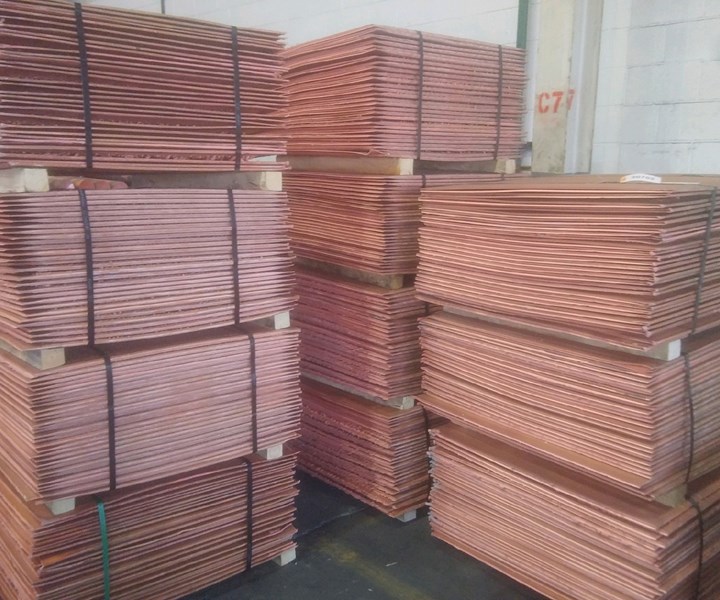Phosphorus Copper Anodes for Acid Copper Plating
Copper anodes produced from pure copper cathodes will result in a copper purity of greater than 99.99% copper, including silver and the alloyed phosphorus, according to Univertical’s André Depew.
Q: How much difference will my plating process improve if I use phosphorus copper anodes?
A: Copper anodes produced from pure copper cathodes will result in a copper purity of greater than 99.99% copper, including silver and the alloyed phosphorus. Excess metallic impurities dissolve into the solution and can build up in the plating bath or deposit onto the plated parts. Metallic impurities can affect stress in the deposit, brightness of the deposit, organic brightener consumption and control of the process. The impurities also affect the grain boundaries of the copper anode and how the anode dissolves. This can lead to copper particles being released into the plating system, resulting in roughness. It can also lead to excessive sludge forming as the anodes dissolve, leading to blinded anodes, more frequent anode bag changes, downtime and scrap.

Here are some key items to know about phosphorus copper anodes:
Phosphorus Alloy: Phosphorus is purposely introduced into copper anodes designed for use in acid copper plating. A black film develops as a result of the phosphorus in the anode as the anode dissolves. This film prevents fine pieces of copper from falling off the anode as sludge and also retards chemical corrosion of the anode by the sulfuric acid during downtimes. Anodes with large grain structures will eventually develop a black film, but this film will not be adherent and quickly turns into sludge. The sludge contains what could have been usable metal that is now just a source of roughness and can plug up anode bags, requiring more frequent change out. Phosphorus content specifications are typically .040 to .065%. However, it is best to have a more carefully controlled range of .051 to .059%. Metallurgically, impurities or purposeful inclusions (such as phosphorous) will be located at the grain boundaries. Therefore, the phosphorous required for acid copper plating is most evenly distributed in fine-grained anodes. Distribution of the phosphorous is equally important as the overall phosphorous content. Time to form black film on a phosphorus copper anode can be measured using a laboratory corrosion test for anode material. An anode with the proper phosphorous content and distribution will form the black film in about 30 minutes. Poorly formed anodes can take six hours or more to form a black film and the film will continue to sluff off, forming excessive sludge and metal flakes.
.
Grain Structure: Copper grain structure is one of the most important and yet least known physical properties of the anode. Fine uniform grain structure yields superior plating. The manufacturing methods determine grain structure. Casting of copper is the simplest and least costly method of manufacture. However, cast coppers cannot produce the fine grain structure needed for best anode performance. The higher the casting speed the larger the grain size will be. Fine grain anodes require some type of subsequent treatment after casting. Usually this involves hot extruding or hot forging. When the copper is formed under high pressure and temperature, the grain structure is reformed into a very fine and uniform size. When copper cools, it extrudes impurities out of the crystal to the boundary between the crystals. The growth of grains produces a similar effect and further extrudes the impurities to the grain boundaries. The physical and chemical strength of the grain boundaries is weaker than the inner grain or crystal portions. During a plating process, the grains can be undercut and blow away from the anode as copper grit or dust. When the grit is allowed to reach the cathode, the particles can cause bumps or roughness. When the particles are captured by anode bags, they will form sludge, blinding the bags. The copper particles may also dissolve into the plating solution, causing an increase in copper ion concentration.
Cleaning: The objective of cleaning and deburring copper anodes is to produce an oil, smut, sharp edge and oxide-free surface on the anode. Oils, smuts and oxides on the surface of the anode can result in nonuniform dissolution of the anode, increase in sludge formed and an increase in copper particles released. Poor cleaning can also introduce unwanted soils into the plating solution. The preferred way to clean a copper anode is using an alkaline solution that removes soils and oxidation. This leaves a clean surface which will readily form the black film desired for plating. This method also eliminates the chance for acid residue on the copper anode, which can result in green or black corrosion on the anode surface during storage. The preferred method for deburring is a very slow, gentle tumble of the anodes so that the surface is not mashed down and work hardened as with vibratory cleaning. Vibratory cleaning can flow copper surface encapsulating dirt particles and can also generate flakes that can sometimes be seen in the bottom of the anode containers or even visible on the anode surface after exposure to a “black electrical tape test.” This test is performed by using firm finger pressure to stick black electrical tape to the anode, then quickly ripping the tape off. Flakes can enter the plating solution, causing roughness, anode bag plugging and wasted copper.
Outputs, Copper Ions, Copper Particles and Sludge: The objective of any soluble anode is to produce metal ions in the plating solution, in this case, [Cu – 2e = Cu++]. Metal particles and sludge are unwanted side effects. Heavy anode sludge means costly downtime for replacing bags, draining tanks and removing sludge. Sludge is composed of nonionic particles or contaminates that remain suspended in the solution, get trapped in the anode bag pores or settle to the bottom of the bag or the plating tank. Anode bags are not the entire solution. Partials are either larger than the pores of the bags, about the same size as the pores or smaller than the pores of the bag. The larger particles tend to fall to the bottom of the bag and are just wasted copper. The smaller particles can penetrate the bag pores and wind up in the plating solution, causing roughness on the plated parts. The medium-sized ones tend to enter the pores of the anode bag and quickly blind the bag, requiring the bags to be changed and resulting in downtime. High purity copper anodes with small grain size and uniform distribution of phosphorous will result in a controlled steady dissolution of copper metal into copper ions in the plating electrolyte. High quality anodes are evidenced by high purity, small uniform grain structure, quick formation of black film, absence of green or black corrosion on surface or in cracks, and absence of flakes.
Costs, Copper Anodes, Anode Bag Changes, Plating Distribution and Rejects: Not all copper anodes are the same. A copper anode is a manufactured product. Different manufacturers use different methods and specifications, and these differences result in a different end product. Total cost of ownership is the total cost to use a product. In the case of phosphorus copper anodes (in addition to the cost of the anodes), the total costs include anode bags, downtime for desludging, sludge disposal, poor plating distribution when anode bags begin to plug, and plating rejects from particles
The conclusion is that quality pays for itself. A better quality anode has lower overall operating costs.
André Depew is a regional sales representative for Univertical Corp. Visit univertical.com
Related Content
Choosing and Troubleshooting Copper Electroplating Processes
Learn more on this inexpensive and highly efficient process.
Read MoreAutomated Electroplating Systems
Simultaneous engineering reduces energy and resource consumption.
Read MoreNickel Electroplating
Applications, plating solutions, brighteners, good operating practices and troubleshooting.
Read MoreHow to Choose Between Sulfate and Chloride-Based Trivalent Chromium
There are several factors to consider when choosing between sulfate and chloride-based baths for trivalent chromium plating. Mark Schario of Columbia Chemical discusses the differences and what platers should keep in mind when evaluating options.
Read MoreRead Next
The 2024 Ford Mustang: All the Colors Available
Although Chevrolet has announced the end of the Camaro and Dodge is offering “Last Call” editions of the Charger and Challenger, the Ford Mustang is launching to its seventh generation.
Read MoreEpisode 42: An Interview with Robin Deal, Hubbard-Hall
Hubbard-Hall wastewater treatment specialist Robin Deal discusses the latest trends in wastewater management.
Read MorePowder Coating 4.0: Smarter, Faster, More Efficient and Connected
New tools reduce cost and waste, lower manufacturing footprint of powder coating operations.
Read More






























